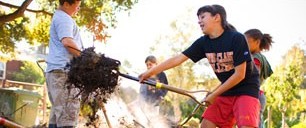 Hands-on education at Berkeley’s Edible Schoolyard. Photo: Edible SchoolyardFor several years starting in the early ’90s, I worked as a remedial math and writing teacher at Austin Community College. At that time–and, for all I know, now–the Texas public education system was mercilessly stratified: high-income districts lavished resources on schools, while their counterparts in low-income districts scraped by on bare-bones budgets. Predictably, college acceptance rates were much higher in the high-income districts.
Hands-on education at Berkeley’s Edible Schoolyard. Photo: Edible SchoolyardFor several years starting in the early ’90s, I worked as a remedial math and writing teacher at Austin Community College. At that time–and, for all I know, now–the Texas public education system was mercilessly stratified: high-income districts lavished resources on schools, while their counterparts in low-income districts scraped by on bare-bones budgets. Predictably, college acceptance rates were much higher in the high-income districts.
That brazenly unequal system churned out plenty of customers for our remedial services. What struck me about many of my students was that they seemed to have never really been engaged before in a classroom: they expected rote, mechanistic, abstract assignments. And they expected to do poorly on them.
So I tried to engage them–cast around for topics they were interested in, concrete things, and use them to explain math concepts, or inspire an essay. And, more often than not, it worked–the students and I would hit upon something, amid much back and forth, that sparked genuine interest, and then they would be off and running, giddy in the pursuit of ideas. Which, of course, is exactly the kind of teaching that goes on in lots of private schools–the ones that routinely send students to esteemed universities, and not remedial programs at community colleges.
It’s not exactly a radical idea. Teaching is a form of communication; and focusing on concrete things has long been a favored communication strategy. In their celebrated guidebook to writing The Elements of Style, Strunk and White advise, “use definite, specific, concrete language.” The advice seems impeccable.
The Edible Schoolyard program, launched in Berkeley public schools by Alice Waters, is an attempt at putting that principle in action. It makes food, a material reality that everyone interacts with daily, an object of hands-on study. See that lettuce on your plate? Where did it come from? How do seeds germinate? What variety of lettuce is it? Why this variety and not another one? Why are only one or two available at the grocery store? Who owns grocery stores–and who decides what they offer. What makes plants grow? And so on.
The idea of having kids grow and cook food as part of the curriculum seems brilliant: a way to make concrete such potentially abstract topics as biology, chemistry, history, economics, and botany. It also promises leverage in another direction: in an age of de-funded, low-quality school lunches and surging diabetes rates among children, Edible Schoolyard has the potential to transform kids’ dietary habits.
Has it worked in practice? That’s a fair question. The program has been around for nearly 15 years now–it started in 1995 at Martin Luther King public middle school in Berkeley, and has expanded to affiliates in New Orleans, among other places across the country. Similar programs have sprouted up elsewhere, inspired by its example. Has it succeeded in catching students’ interest and making them better learners? Has it helped them develop healthier eating habits?
In a scathing piece in The Atlantic, the writer Caitlin Flanagan raises those questions but doesn’t answer them. Or, more properly, she declares the program a disaster–the piece is titled “Cultivating Failure”–without even coming close to driving home her case.
In her 3500-word polemic, the only hard evidence she brings to bear for her verdict of failure is this:
Indeed, Hispanic students do particularly poorly at King Middle School. According to the 2009 Federal Accountability Requirements, statewide, more than 39 percent of Latinos are proficient in English and 44 percent in math, but at the King school, those numbers are a dismal 30 percent and 29 percent, respectively. Where do Berkeley’s African American and Hispanic middle-schoolers do well? At a gardenless charter school called Cal Prep, where 92 percent of the students are black or Latino, where the focus is on academic achievement, and where test scores have been rising steadily.
So at King, Latinos are underperforming on standardized tests, while over at Cal Prep, “test scores have been rising steadily.” You don’t need to be a social-sciences graduate student to marvel at the logical gymnastics on display here. Correlation does not show causation; students could be underperforming at King because of the garden program–or because of some other reason. And so on. The numbers she cites may call into question the efficacy of Edible Schoolyard, but they by no means settle the case.
And that’s her last nod to bringing empirical evidence to bear. (In another jaw-dropping section, she seeks to debunk the concept of food deserts–the idea that residents of low-income areas tend to have less access to fresh food–not by scrutinizing the considerable academic research on the topic, but rather by making a 20-mile trip to “the most famous American hood [sic], Compton,” to check out the grocery scene.)
Her point seems to be this: working the land and cooking are lowly tasks, work that should be fled and not aspired to. It’s unconscionable to urge Latino students, some of whose parents may work as migrant laborers, to garden as a form of learning. Students, particularly those struggling with basic reading and math, should be forced to hit the books, not weed the carrots.
That line of reasoning seems brutally reductionist–and certainly doesn’t reflect my own experience as a remedial teacher. More importantly, Flanagan makes no effort to actually engage the program she is trashing (or, indeed, the book she’s ostensibly reviewing–her piece is ludicrously packaged as a review of Thomas McNamee’s 2008 biography of Alice Waters).
And the idea that farming and cooking–and even getting one’s hands dirty in the garden–are beneath respectable middle-class aspiration is deeply problematic. Such thinking reinforces an unjust food system that exploits cheap labor as a matter of course, propped up by a largely invisible army of migrant workers who do the dirty work of tending fields, slaughterhouses, and kitchens.
The sustainable-food movement has matured enough and gained enough force that it’s coming under withering criticism from a variety of quarters. That’s good for the movement–hard questions need to be asked, assumptions questioned, received ideas reconsidered. And authors who perform those tasks will find a market from editors desperate to generate attention with contrarian poses.
But I wish we could expect more thoughtfulness, and less hack work, from such critics.




